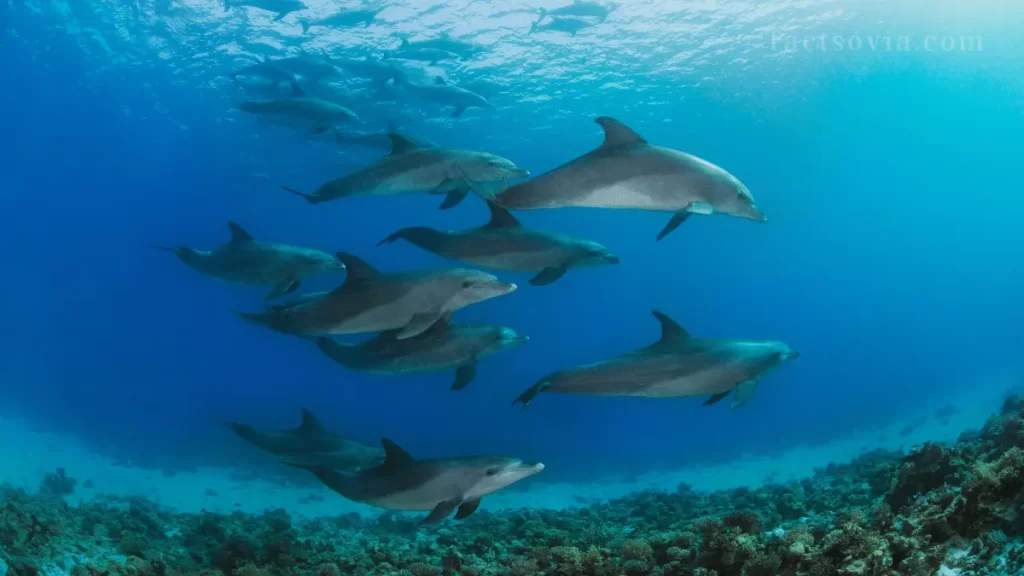We use affiliate links to run our site. When you buy through links on our site, we may earn an affiliate commission, without any added cost to you. Learn more
Dolphins are some of the most fascinating creatures on the planet. Not only are they incredibly intelligent and playful, but they also have some pretty amazing characteristics that make them stand out from other animals. One of these unique traits is their lifespan.
While many people assume that dolphins have a short life expectancy, the truth is that these creatures can live for decades in the wild.
In this blog post, we’ll dive into the details of the surprising life expectancy of dolphins and what factors contribute to their longevity.
How long do dolphins live?
The answer to this question depends on a variety of factors, including the species of dolphin, their environment, and even their genetics. In general, however, most dolphins have a lifespan of 20 to 50 years in the wild.
The average life expectancy of a dolphin in captivity is about 28-29 years. This number comes from studying dolphins at aquariums and marine parks across the United States.
This is a significantly longer lifespan than many other marine animals, such as fish or crabs. In captivity, dolphins may live even longer, with some individuals living into their 60s or 70s.
What factors contribute to a dolphin’s long lifespan?
Several factors can impact a dolphin’s lifespan. One of the most important is their environment.
Dolphins who live in the wild and have access to a healthy diet and clean water are more likely to live longer than those living in polluted or overfished areas.
Additionally, social factors such as a strong family group or pod can also contribute to a dolphin’s longevity.
Are there any species of dolphins that live longer than others?
Yes, some dolphin species are known to live longer than others. For example, bottlenose dolphins typically have a lifespan of 40 to 50 years, while orcas (sometimes called “killer whales”) can live up to 80 years in the wild.
Certain species of dolphins, such as the Ganges River dolphin, are unfortunately endangered due to habitat loss, pollution, and human activity, which can impact their lifespan and overall survival.

How do scientists study the life expectancy of dolphins?
To understand the lifespan and health of wild dolphins, scientists may use a variety of methods such as tracking their movements and collecting biopsy samples. By analyzing these samples, researchers can gain insights into a dolphin’s age, genetics, and overall health.
Additionally, long-term studies of specific dolphin populations can provide a wealth of information about their lifespan and factors that impact their survival.
Why is it important to understand the life expectancy of dolphins?
Understanding the lifespan of dolphins is important for a variety of reasons. For one, it can help scientists and conservationists develop strategies to protect and preserve certain dolphin species. Additionally, it can help us better appreciate these amazing creatures and their unique characteristics.
By learning more about their lifespan and the factors that impact their survival, we can foster a greater appreciation for dolphins and their importance in our ecosystem.
Dolphin Life Expectancy in Captivity:
When dolphins are kept in aquariums or marine parks, they are protected from predators and environmental threats. Their food, medical care, and living conditions are carefully controlled by humans. But despite this protected lifestyle, captive dolphins tend to have shorter life spans than wild dolphins.
The average life expectancy of a dolphin in captivity is about 28-29 years. This number comes from studying dolphins at aquariums and marine parks across the United States.
The most common dolphin species found in captivity is the bottlenose dolphin. Female bottlenose dolphins have reached ages of over 60 years old in human care. But the average captive bottlenose dolphin lives to be around 30 years old.
Other dolphin species don’t fare quite as well in captivity. Certain species like the spotted dolphin and spinner dolphin often survive less than 20 years when kept captive.
Why do captive dolphins die younger compared to wild dolphins? There are a few reasons:
- Stress – Being confined and unable to roam large distances causes chronic stress for these free-spirited animals. This can weaken their immune system.
- Pollution – Captive dolphins are exposed to higher levels of water pollution from their enclosed tanks. Wild dolphins roam open waters and don’t face this issue.
- Diet – Captive dolphins are fed dead, frozen fish. Wild dolphins catch and eat live fish, which provides more nutrients.
- Lack of stimuli – Marine parks can’t fully simulate the varied ocean environment. Dolphins have fewer opportunities to use their intelligence and echolocation.
While captivity provides safety from predators and starvation, it brings along its own disadvantages. This is why even under human care, most dolphins don’t reach the full life expectancy of their wild counterparts.

Dolphin Life Expectancy in the Wild:
For dolphins living freely in our oceans, their life expectancy jumps up significantly. On average, wild dolphins live between 20-40 years. But many individual dolphins survive well past 40 years old.
The longest-living dolphin species is the bottlenose dolphin. Bottlenose dolphins have an average lifespan of around 40 years in the wild. Though it’s not uncommon for them to reach 50 or even 60 years old.
The oldest known wild bottlenose dolphin was tracked off the coast of Australia and lived to be 63 years old!
Other dolphin species also show impressive life spans in their natural habitats:
- Killer whales – 50-80 years
- Pacific white-sided dolphins – 50-60 years
- Risso’s dolphins – 50-60 years
- Short-finned pilot whales – 45-60 years
What allows wild dolphins to reach such old ages compared to captive dolphins? Their natural habitats give them some key advantages:
- Open ocean – Dolphins roam many miles every day rather than being confined in a tank.
- Natural diet – Hunting live fish provides important nutrients missing from frozen fish.
- Stimulating lifestyle – Navigating the open ocean and interacting with other dolphins keeps their mind active.
- No pollution – The open ocean dilutes and disperses chemical pollutants.
Living in the wild has its own risks like shark attacks, starvation, and storms. But despite these threats, wild dolphins still tend to outlive their captive cousins by over a decade. Their free-roaming lifestyles allow them to reach their maximum natural life span.
Factors That Impact Dolphin Life Expectancy
Now that we’ve looked at life expectancy averages, let’s examine the specific factors that help determine an individual dolphin’s lifespan. These major influences can greatly increase or decrease the years a dolphin survives.
Captivity vs Wild
This is the most obvious factor impacting dolphin life expectancy. As we’ve discussed, captive dolphins die 10-20 years earlier than wild dolphins on average. The restricted environments and stress of captivity prevent most captive dolphins from reaching old age.
Species
Some dolphin species naturally live longer than others. Bottlenose dolphins are the longest-living species, surviving up to 60 years in ideal conditions. Spinner dolphins appear to have the shortest life spans, living only 15-20 years on average. Genetics plays a key role.
Gender
Female dolphins tend to outlive male dolphins by a few years. This is linked to sexual maturity and behaviors. Male dolphins reach sexual maturity earlier and engage in more aggressive and risky behaviors related to reproduction. Such as fighting with each other for access to females.
Geography
Where a dolphin lives impacts its life expectancy. Dolphins near the cooler poles tend to live longer, while those in warmer tropical climates die younger. Cooler water temperatures support longer lifespans.
Diet
Dolphins that eat high-quality diets with sufficient nutrients and calories will live longer. Wild dolphins that catch live fish meet this requirement. Captive dolphins fed thawed dead fish may lack essential fatty acids that promote good health.
Threats
Dolphins exposed to more life-threatening hazards generally have reduced lifespans. For example, dolphins living in waters with lots of motorized boats or sharks may die earlier from collisions or attacks. While less exposed dolphins will survive longer.
Supporting Long-Lived Dolphins
After learning about dolphin life expectancy, it’s clear these intelligent creatures can survive many decades when provided with sufficient care and good living conditions.
In captivity, improving water quality, diet, and enrichment activities could potentially increase captive dolphins’ life spans. Though releasing captive dolphins into the wild once they’ve lost survival skills often does more harm than good.
For wild dolphin populations, we should strive to preserve their natural habitats and food sources. Reducing ocean pollution, ship traffic, and fishing net entanglements allows more dolphins to reach old age. Monitoring key dolphin groups over decades also provides valuable data on what conditions support their longevity.
With more research and care, both captive and wild dolphins may continue to surprise us by living even longer lives. Their grace, playfulness, and intelligence could then brighten human lives for generations to come.
Conclusion:
All in all, the life expectancy of dolphins is a fascinating topic that sheds light on some of the most important aspects of these incredible creatures.
By understanding the factors that impact their survival and longevity, we can work to protect these species and ensure that they continue to thrive for generations to come.
Whether you are a dolphin lover, an animal enthusiast, or simply someone who is curious about the natural world, the lifespan of dolphins is a topic that is well worth exploring.
Amazon and the Amazon logo are trademarks of Amazon.com, Inc, or its affiliates.
